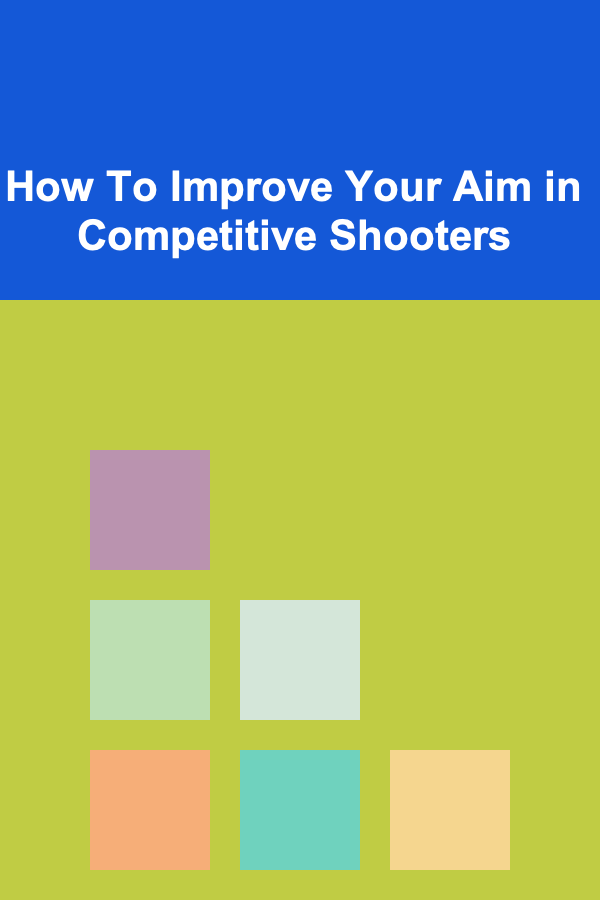
How To Improve Your Aim in Competitive Shooters
ebook include PDF & Audio bundle (Micro Guide)
$12.99$5.99
Limited Time Offer! Order within the next:

Competitive shooting games, whether they are first-person shooters (FPS) or third-person shooters (TPS), rely heavily on the player's ability to aim accurately and react swiftly. Players engage in intense firefights where every shot counts. The better you aim, the better your chances of winning. Improving your aim is not just about having fast reflexes; it involves a combination of strategy, technique, and mental focus.
In this article, we will dive deep into various aspects of improving aim in competitive shooters. From basic mouse settings to advanced techniques, we'll cover a wide range of tips and tricks that can help you become a better player and take your performance to the next level.
Understanding the Importance of Aim
Before diving into ways to improve your aim, it's important to understand why aiming accurately is so crucial in competitive shooters. Unlike single-player games, competitive shooters are fast-paced and require split-second decisions. Missing your shots can give the enemy a chance to retaliate, which often results in your defeat. Conversely, hitting your shots consistently allows you to control the flow of the game, and in many cases, it can determine the outcome of a match.
Aim is one of the few skills that can directly translate into victories. Whether it's landing a headshot or tracking an enemy across the map, the precision of your shots is directly linked to your success. It doesn't matter how well you play strategically or how fast you can react if your aim isn't up to par.
Now that we understand the significance of aim, let's explore the key factors that contribute to great aiming and how to improve them.
Optimizing Your Settings
The first step to improving your aim is ensuring that your game settings are optimized. This doesn't mean simply adjusting the mouse sensitivity to what feels comfortable; it's about setting up an environment that helps you play at your best.
Mouse Sensitivity
Mouse sensitivity plays a vital role in determining how fast your cursor or reticle moves when you move your mouse. Too high sensitivity can make it difficult to aim precisely, while too low sensitivity can make it hard to react quickly. The key to optimal mouse sensitivity lies in finding a balance that works for you.
A common recommendation for competitive shooters is to use a "low to medium" sensitivity setting. This provides better control over small movements, which is essential for making accurate shots. Many professional players use low sensitivity settings to help them fine-tune their aim during long-range gunfights, while also allowing for quick reactions when needed.
To test your sensitivity, try adjusting it incrementally until you find a setting where you can comfortably track and flick to targets. Another trick is to practice precision aiming with a specific target, like a dot or a moving object, to check how comfortable you are with your sensitivity.
Mouse DPI
DPI (dots per inch) refers to the sensitivity of your mouse at the hardware level. A higher DPI means your mouse will register smaller movements. However, this is not always better. Professional players often set their mouse DPI to somewhere between 400 and 800 DPI. The reason for this is simple: lower DPI means more precise control over your aiming. Experimenting with different DPI settings alongside your in-game sensitivity will help you find your sweet spot.
Display Settings and Refresh Rate
Having the best possible display settings and a high refresh rate monitor can make a significant difference. Competitive shooters require quick reactions, and having a 144Hz or 240Hz monitor can provide smoother gameplay, helping you spot enemies faster and track their movements more fluidly. Additionally, ensure that your game is running at a high frame rate (FPS) to reduce input lag, which is critical in fast-paced games.
Adjusting visual settings for better clarity also helps. Reducing graphical clutter, such as shadows, can help you focus on enemy movements. High contrast can make it easier to spot opponents in dark areas of the map, while improving visual sharpness can make your aim feel more accurate.
Field of View (FOV)
A higher FOV allows you to see more of your surroundings, which can be advantageous in combat situations. However, too high of an FOV can distort your view and make it harder to aim accurately, especially at long ranges. Many professional players set their FOV somewhere between 90 and 110 degrees to get a good balance of visibility and precision.
Training Your Aim
Having the right settings is essential, but your skill level will ultimately depend on how much time you spend training. Aim training is not just about reacting quickly but also about honing your muscle memory and learning the patterns of the game. Below are some practical training methods to enhance your aim.
Aim Trainers
One of the most effective ways to improve your aim is through specialized aim trainers. These programs are designed to help you practice and develop muscle memory by repeatedly performing target exercises. Popular aim trainers such as Aim Lab, Kovaak's FPS Aim Trainer, and Reflex Arena offer various drills to improve different aspects of aiming, including tracking, flick shots, and reflex shots.
Aim trainers allow you to customize your drills to fit your needs, whether you want to work on close-range aim or long-range accuracy. They provide immediate feedback, and you can track your progress over time. Practicing in these trainers for 15-30 minutes each day can show significant improvements in your gameplay.
In-Game Training Modes
Most competitive shooters, like "CS:GO," "Valorant," and "Overwatch," come with training modes that allow you to practice your aim against bots or targets. These modes are great for warming up before a match, especially since they replicate real game conditions. You can practice shooting static targets, moving targets, or aim at different ranges to simulate actual gameplay scenarios.
Flick Shots and Tracking
There are two primary types of aiming you'll encounter in competitive shooters: flick shots and tracking. Flick shots involve quickly moving your crosshair to a target and shooting, while tracking involves following a moving target and keeping your aim on them.
To improve your flick shots, practice "flicking" your crosshair from one target to another. This can be done in aim trainers or in the training modes of your game. Work on making your flicks as smooth and accurate as possible.
Tracking requires you to maintain your aim on a moving target, which can be trickier, especially in games with fast-moving characters or objects. To improve tracking, try to follow bots or other players as they move around the map. Focus on the target's movement patterns and learn how to predict where they will go next. The more you practice, the better your muscle memory will become.
Reflex Training
Reflex shots are incredibly important in competitive shooters because you often have to react to enemies popping into view or making quick movements. To train your reflexes, practice aiming and shooting at targets that appear randomly on the screen. Many aim trainers have reflex-based drills that simulate these situations.
You can also practice reflex shots in the game by focusing on quick, snap shots when you spot an enemy. These types of drills help sharpen your reaction time and ensure you're ready for any surprises during real matches.
Developing Good Habits
Improving your aim goes beyond just technical adjustments and training. There are several key habits and mindset practices that can help you maintain consistency and focus during matches.
Patience and Focus
In competitive shooters, one of the most important things to cultivate is patience. You may find yourself in long, drawn-out gunfights, where you need to wait for the right moment to take a shot. In these situations, being too hasty can cause you to miss. Practice staying calm and waiting for the optimal time to fire, rather than rushing into a shot.
Focus is equally crucial. Avoid distractions during your gameplay, and be aware of your surroundings. Knowing when to engage and when to hold back is just as important as having good aim. Maintaining concentration allows you to react faster and make better decisions during high-pressure moments.
Regular Breaks
Training your aim can be exhausting, and playing for extended periods without rest can lead to fatigue, which affects your performance. Taking regular breaks will help keep your mind fresh and allow you to perform at your peak. Overplaying can also cause unnecessary stress, so balance your training sessions and ensure you're getting enough rest.
Game-Specific Tips
Each competitive shooter has its own mechanics, so it's important to tailor your training and techniques to the specific game you're playing. Here are some game-specific tips:
CS:GO
In "CS:GO," headshots are often the key to winning gunfights. One of the best ways to improve your aim in this game is to practice your crosshair placement. Keeping your crosshair at head level and aiming for the head will give you an advantage in duels. In addition, practicing spray control is important for mid-range combat, as the AK-47 and M4A4 rifles have recoil that must be managed.
Valorant
"Valorant" has a unique aiming system with agents who have distinct abilities. To improve your aim in "Valorant," focus on mastering the movement mechanics. Stopping your movement before shooting is crucial for better accuracy, as moving while shooting drastically reduces your accuracy. Practice your crosshair placement and aim for headshots, especially when using rifles like the Vandal.
Apex Legends
In "Apex Legends," the movement is fast, and players often slide or use their jetpacks to dodge incoming fire. To improve your aim, practice tracking targets while maintaining movement. Since the game uses various weapons with different recoil patterns, it's essential to practice spray control for each weapon.
Conclusion
Improving your aim in competitive shooters requires a combination of technical adjustments, regular practice, and a mindset that focuses on patience and consistency. By optimizing your settings, practicing specific drills, and developing good habits, you can become a more accurate and efficient player.
Remember, becoming proficient at aiming takes time. Don't expect immediate results. With dedicated training and persistence, your aim will improve, and you'll see the difference in your overall performance. Whether you're a casual player or aspiring to be a professional, improving your aim is one of the most rewarding aspects of competitive gaming.

How to Integrate SMS Automation Tools with Your Dropshipping Platform for Abandoned Cart Recovery
Read More
How To Overcome Imposter Syndrome in Your Career
Read More
How to Turn Your Deep Learning Knowledge into Profitable AI Tools
Read More
Lead with Impact: How to Stand Out by Inspiring Others
Read More
How To Prevent Insomnia Naturally
Read More
Sustainable Travel on a Budget: Exploring the World Responsibly
Read MoreOther Products

How to Integrate SMS Automation Tools with Your Dropshipping Platform for Abandoned Cart Recovery
Read More
How To Overcome Imposter Syndrome in Your Career
Read More
How to Turn Your Deep Learning Knowledge into Profitable AI Tools
Read More
Lead with Impact: How to Stand Out by Inspiring Others
Read More
How To Prevent Insomnia Naturally
Read More